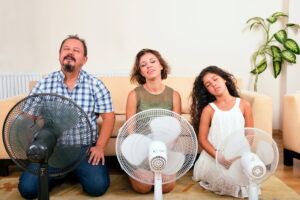When it comes to indoor air quality, many people focus on reducing humidity levels, especially during the warmer months. However, overly dry air can be just as harmful to your health and home as excess humidity. Striking a balance between dry and humid air is essential for creating a comfortable and healthy indoor environment.
Let’s explore why dry indoor air can be just as problematic as humid indoor air and how whole-house humidifiers in Frederick, MD, can help.
The Dangers of Dry Indoor Air
Dry indoor air occurs when the humidity level drops below 30%. This can happen during the winter when heating systems are running constantly or in climates with naturally low humidity. Here are some of the problems caused by dry indoor air:
Health Issues
- Respiratory Problems: Dry air can irritate your nasal passages, throat, and lungs, leading to coughing and congestion. It can also worsen conditions like asthma.
- Dry Skin and Eyes: When humidity levels are low, your skin and eyes can become dry and itchy, especially if you already suffer from conditions like eczema.
- Increased Risk of Illness: Viruses like the flu thrive in dry environments, increasing your risk of getting sick.
Damage to Your Home
- Cracked Wood and Furniture: Low humidity can cause wood to shrink and crack, damaging furniture, floors, and even musical instruments.
- Static Electricity: Low humidity increases static electricity, which can be annoying and potentially damaging to electronics.
- Peeling Paint and Wallpaper: Dry air can cause paint and wallpaper to peel or crack, leading to costly repairs.
How Humid Indoor Air Can Also Be a Problem
While dry air presents challenges, overly humid air comes with its own set of issues. When indoor humidity exceeds 60%, you might experience the following:
- Mold and Mildew Growth: High humidity creates the perfect environment for mold, which can cause health problems and damage your home.
- Dust Mites: These pests thrive in humid environments, contributing to allergies and asthma.
- Musty Odors: Excess moisture can lead to unpleasant, musty smells, making your home feel uncomfortable.
Finding the Perfect Balance
The ideal indoor humidity level is between 30% and 50%. Maintaining this range can help prevent issues associated with both dry and humid air. Here’s how to achieve balanced humidity:
- Use a Humidifier: A whole-house humidifier adds moisture, making the air more comfortable, especially during winter.
- Use a Dehumidifier: During warmer months, a whole-house dehumidifier can help reduce excess humidity, preventing mold growth.
- Monitor Humidity Levels: Invest in a hygrometer to track humidity levels, adjusting your humidifier or dehumidifier as needed.
Why You Need Humidifiers
If you’re struggling with dry indoor air, investing in a whole-house humidifier can make a significant difference in your comfort and health. Using whole-house humidifiers is an effective way to maintain proper humidity, especially during winter.
Balancing indoor humidity is crucial for a healthy environment. If you’re unsure how to maintain the right humidity, consult with a professional HVAC company.
Call B&B Air Conditioning & Heating Service… We are always there when you need us.



